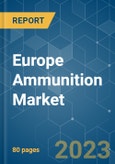The impact of the COVID-19 pandemic on the European ammunition market revenues is deemed to be less. The growth in Europe defense spending and initiation of infantry support programs to develop sophisticated newer generation ammunition with better penetrating power is expected to drive the growth of the market.
As per the 2016 Global Strategy, Europe seeks to attain strategic autonomy by 2025. Thus, the European Union (EU) nations have undertaken a multifaceted modernization program to achieve a higher degree of military capability. This has resulted in the initiation of several procurement programs for advanced weaponry and compatible ammunition. However, the complexity of international security challenges has become more prominent, and the economic recession caused by the COVID-19 pandemic is envisioned to force governments to make difficult choices in their defense budgets that will greatly affect their near- and long-term military capabilities and procurement programs.
The Russia-Ukraine war has changed the scenario of the defense sector in Europe. Most of the European countries witnessed a shortage of weapons and ammunition as they sent a large number of weapons and other equipment to Ukraine. Furthermore, the large number of arms and ammunition used by both countries led to a shortage of ammunition. According to the United States defense official, Russia is firing nearly 20,000 rounds per day while Ukraine is firing around 4,000 to 7,000 daily. Thus, a huge demand for weapons, ammunition, and other defense equipment from European countries drives the market's growth.
Europe Ammunition Market Trends
Increasing Defense Expenditure from European Countries Drive the Market Growth
The European countries increased their defense budget due to growing warfare situations in the region, such as Russia’s invasion of Ukraine, cross-border conflicts, and rising terrorism. The total military spending in Europe in 2021 amounted to USD 418 billion, 3.0% higher than in 2020. The aggregated military expenditure of Central and Western Europe, two subregions including most NATO allies and all European Union member states totaled around USD 342 billion in 2021.In February 2022, the German government committed USD 112.7 billion to the armed forces. The increased defense budget was due to Russia’s invasion of Ukraine, including investments and armament projects for the German military forces. Furthermore, the French Ministry of Armed Forces has proposed a USD 42.9 billion defense budget for 2023, which shows an increase of 3 billion from the previous year. Also, the growing procurement of advanced weapons and ammunition drives the market's growth across Europe. For instance, in June 2022, the French Army started quickly procuring American-made loitering munitions as part of a longer-term effort to field remotely operated weapon systems.
Russia to Generate the Highest Demand for Ammunition
Russia is the largest defense spender in Europe, with a defense budget of USD 65.9 billion in 2021. The ongoing war between Ukraine, cross-border conflicts with NATO countries, and growing terrorism across the country lead to a rise in demand for defense equipment and ammunition. Russian military expenditure grew for the third consecutive year in 2021. Russia's spending rose by 2.9% to reach USD 65.9 billion.The Russian military could see massive arms shortages before the end of the year as it continues its military occupation of Ukraine. Recent sanctions on Russia and successful counter offenses by Ukrainian troops have led to rapid declines in its stockpiles of artillery shells and armored vehicles, while its ability to conduct air strikes and fire-guided missiles will likely be exhausted by year's end. This is expected to lead to an increase in ammunition procurement in the forecast period.
In April 2020, the Russian design bureau Military Industrial Company (MIC) initiated battlefield testing on the latest VPK-Ural armored vehicle, designed to transfer a maximum of 12 fully geared personnel safely on the battlefield. In the event of successful testing, MIC could be awarded a contract under the Russian military's rearmament program until 2027. Russia is actively inducing the BMPT armored vehicle designed to carry a mix of missiles, light cannons, and machine guns that can engage various targets, ranging from enemy tanks to ground troops. During the full-scale war with Ukraine, the Russian military troops used more than 7 million shells in the last six months. Thus, growing defense expenditure and rising procurement of munitions are expected to drive the market's growth during the forecast period.
Europe Ammunition Market Competitor Analysis
The European ammunition market is consolidated as only selected vendors, manufacturers, and supply weapons and ammunition in the region due to the high technological expertise required to produce military-grade weapons. Some of the prominent ammunition manufacturers in the region are BAE Systems PLC, Rheinmetall AG, General Dynamics Corporation, Nexter Group, and Rostec State Corporation.Rheinmetall AG continues to expand its role as a major ammunition supplier in the region. For instance, in September 2022, Rheinmetall and its partner UVision won the first order from a major European NATO military force for HERO loitering munitions. The formation of a special force ordered Hero-30 combat and training munitions, a simulator, training courses, and integrated logistics equipment and support.
Additional benefits of purchasing the report:
- The market estimate (ME) sheet in Excel format
- 3 months of analyst support
This product will be delivered within 2 business days.
Table of Contents
Companies Mentioned (Partial List)
A selection of companies mentioned in this report includes, but is not limited to:
- Rheinmetall AG
- Nexter Group
- BAE Systems PLC
- General Dynamics Corporation
- Denel PMP
- Saab AB
- Elbit Systems Ltd
- Rostec State Corporation
- Nammo AS
- Heckler & Koch GmbH
Methodology

LOADING...










